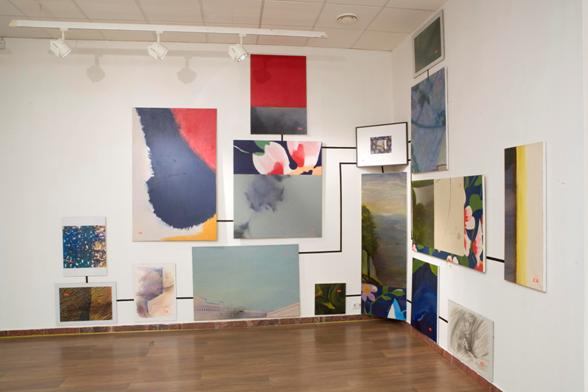Ivan Chuikov’s Theory of Reflection
Stella Art Foundation, Moscow, February 28- March 30th 2008
In the exhibition Theory of Reflection 1 (1978-92) and Analytical Tree (1994) on view during this spring at the Stella Gallery, the installations by Ivan Chuikov confront the viewer with an intriguing experience of visual play. Five identical installations of still-lifes are placed in front of free-standing round-headed frames that hold either a glass mirror or cardboard, or are left empty. The traditional nature morte doubles when reflected in a mirror, takes on Cubist forms when painted on cardboard , or vanishes completely when placed by the artist beyond the wooden frame. It is as if the artist leads the viewer along the installation explaining the laws of perspective, didactically pointing and naming out the objects: this is an apple; a bottle…a glass….
Starting from the 1970s, Chuikov – one of the key figures of Moscow Conceptualism – analyzed formal bases of perception and its illusions. His method is literal and ironic. Like many non-conformist artists such as Kabakov and Pivovarov, Chuikov used the language of official art, which these artists had to use to work for money. As an example, Kabakov’s day-time job was illustrating children’s books. Chuikov, on the other hand, helped in the studio of his father who was a member of the All-Artists’ Union. As a consequence, the formal language of the academia verbalized his quizzing of relations between reality and its representation.
“What then is the relationship between a fragment and its enlarged copy?” asks the artist in his painterly installation Analytical tree, a work that takes over one corner of the Stella gallery’s wall space. Here Chuikov enlarged a minuscule piece of a Soviet-time postcard covered in a flower pattern by one hundred times until it filled up the area of a separate canvas. He then took a tiny fragment of the latter and repeated the process until all parts of the initial painting turned into individual abstractions; literally blobs of color. Through the different mediums of acrylic, oil, graphite and photocopies, the artist equally distorts the original metric scale. To trace the order and development of the enlargements, Chuikov connects the pieces of Analytical tree by a number of black lines that are governed by a mathematical formula. Quite apart from its formal exploration, the installation could be read as a genogram of episodes that constituted life during the Soviet epoch: thin cardbord, cheap print and an inflated reality of an over-sized utopia.
Chuikov’s installations subvert Lenin’s theory of reflection (the basis of the style of Soviet Socialist realism is its truthful depiction of reality). For him, reality cannot be described through a singular system of values or ideology, but exists only in the plurality of representations. In Theory of Reflection 1 he included two sketches of the same still-life: one expressionistic and the other cubist – to illustrate his point. The artist said in his 1983 manifesto, “It is impossible to represent the world, we can only portray it.” Furthermore, Chuikov describes representations as an “image, which is a thin coat laid upon two- or three-dimensional construction. The image may resemble, might only partially match or completely differ from this construction (reality).”
Here, Chuikov problematises the relationship between a concept and its visual and verbal references, andby doing so follows the conceptual experiments of Western artists. In a similar way to Joseph Kosuth’s pivotal work One and Three Chairs, Chikov creates a range of proxies for his initial referent: a still-life in the first installation and a post-card fragment in the second. When looking closely at the works, the viewer is forced to ask what is real here: an object or its symbol.
The Moscow-based Stella Art Foundation recently acquired two early period installations by Chuikov. The first work was initially exhibited at the Regina gallery in 1992, whilst the second was shown in Russia for the first time. By presenting a fuller spectrum of the artist’s oeuvre, it is no coincidence that a painting by Kosuth has also taken a prominent place on the Stella Gallery walls.
This review is an expanded version of a review originally commissioned by Flash Art.








